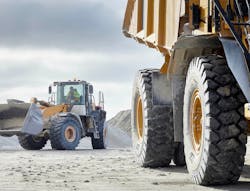Despite supply chain constraints, the North American OTR tire market made a dramatic rebound in 2021. Infrastructure projects, elevated commodity prices and other factors will help ensure that demand for OTR tires remains robust in the new year, according to tire manufacturers.
Here’s a look at how and why the OTR tire market turned around. Suppliers also share their forecasts for 2022 and discuss trends that OTR tire dealers should monitor as business continues to boom.
MTD: Can you describe what OTR tire demand was like in 2021?
Chris Rhoades, assistant vice president, OTR, BKT USA: OTR tire demand in 2021 rose above pre-COVID-19 levels, despite supply chain and logistics issues. Aggregates and construction demand continued to grow at a normal pace.
Tony Cresta, product manager of commercial products, China Manufacturers Alliance LLC (CMA): In 2021, we saw OTR tire demand increase from an overall, roughly flat 2020.
Shawn Rasey, director of global business development, earthmover tires, Continental Tire the Americas LLC: The rebound in demand was a bit sharper and more pronounced than we anticipated coming off a patchy 2020, which was affected by COVID-19. That rebound was pretty much sustained throughout the year, with both dealers and end users going back to work. Like most industries and businesses, we did see some limitations on growth, fueled by both labor shortages and tire supply.
Loic Ravasio, general manager, global and Americas OTR, Goodyear Tire & Rubber Co.: OTR tire demand continued to recover in 2021. While demand for mining tires was slightly behind other OTR segments, we expect it to return to pre-pandemic levels in 2023.
Jimmy McDonnell, vice president of sales and marketing, Maxam Tire North America: Overall, special tire demand was strong. Many construction projects related to infrastructure improvements proved to drive demand post-COVID-19. Heavy equipment operators saw strong demand for new machines, with growth only limited due to supply chain issues with components. Machine inventories are still very low and have not been rebuilt yet.
Jaye Young, mining business line marketing director, Michelin Group: Tire demand was very strong in both the quarry and mining sectors, driven by recovery-focused infrastructure investments, increased energy consumption and demand for commodities like copper, iron ore and nickel needed to support the transition to sustainable energy sources like batteries, windmills and solar panels.
Stephen Reynolds, OTR director, Triangle Tire USA: There was strong demand for both haulage and loader tires throughout 2021 that seemed to be evenly distributed among mining, construction and quarry segments. Typically, you would think of late-November and most of December as the slower time of the year. However, Triangle saw record sales in November and December.
Bruce Besancon, vice president, marketing and strategy, Yokohama Off-Highway Tires America Inc.: The 2021 OTR tire business was like a gold rush and tires were the gold. After losing 20% to 30% of their sales in 2020, dealers and original equipment manufacturers came back strong in 2021 — gaining back what they’d lost and continuing to build strength right through the end of the year and into 2022. While customers were calling for tires, manufacturers were working hard to increase capacity, meet demand and shore up their partner-dealer relationships.
MTD: What’s your forecast for 2022?
Rhoades (BKT): We don’t see demand slowing down for 2022 and are predicting a record growth year for BKT. We are continuing to increase capacity for key sizes, as well as adding mining tires like 37.00R57, 40.00R57 and 50/65R51 to round out our offerings. Shipping costs continue to be at record highs, but we are seeing an improvement on shipping times, as well as ports clearing.
Cresta (CMA): So far, we have seen indications that 2022 will continue to be an uptrend for OTR tires. Both our warehouse stocking orders and customer factory-direct orders increased from the fourth quarter of 2020 to 4Q 2021. This means keeping our newest warehouse in Houston, Texas — as well as our southern California and Memphis, Tenn., warehouses — stocked with an increasing amount of sizes and SKUs to meet demand. The North American OTR tire market is the largest in the world and with large investments being made in infrastructure and the expansion of the leisure industry — construction of hotels, stadiums and casinos is on the rise — the market is poised to continue to grow.
Rasey (Continental): We’re anticipating a strong start to 2022 related to demand, perhaps tapering off a bit by the end of the year. It’s always difficult projecting forward demand and that is particularly the case this year, with continued uncertainties related to COVID-19 spikes, possible continued labor shortages, tire manufacturers playing catch-up related to supply and regional differences in dealing with COVID-19 containment policy. Overall, it feels like demand in 2022 should be equal to or slightly better than 2021, if supply is available to support it.
Ravasio (Goodyear): Our forecast for 2022 includes a continual upturn across all segments.
McDonnell (Maxam): We are forecasting strong growth for 2022. In North America, economies are emerging from the global COVID-19 pandemic. The U.S. government has passed an infrastructure bill that is going to yield strong growth for the specialty tire market for years to come — building momentum through 2022 and really kicking in (during) 2023, when new projects are expected to be started and underway.
Young (Michelin): We will see continued growth in demand in 2022. In fact, 2022 will return to pre-COVID-19 levels of demand.
Reynolds (Triangle): All indications are that demand will increase in 2022, particularly in the construction and quarry segments. With the passing of the infrastructure bill, staples of the industry — like concrete production and road construction — should thrive, putting pressure on the struggling supply chain to keep up. The cause for concern is that no one is able to predict when ocean freight might start to return to normal and some of the models we’ve seen are predicting no real relief until the end of the year.
Besancon (Yokohama): I think 2022 is going to be a continuation of 2021. Equipment manufacturers are working as hard as they can to meet demand for new machines and that demand is going to continue as the economy keeps expanding and new infrastructure improvements get underway. Right now, machinery is moving all over the country. Quarries are busy, mines are busy, logging and construction are being driven by a huge market for new homes and container handlers are moving 24/7 at ports. Every segment we serve is running in high gear.
MTD: What are some trends that OTR tire dealers should monitor in the new year?
Rhoades (BKT): OTR tire dealers are being met with price increases, as well as freight surcharges, that have to be communicated to the end user. Even though we are not in a large shortage cycle, it is still just as important for dealers to forecast their customers’ needs and communicate with manufacturers to ensure they have a continual supply of the necessary tires.
Cresta (CMA): With global supply chains lessening but nevertheless extending into 2022, it will be as important as ever to manage your demand and orders with your OTR tire suppliers. In 2021, delivery times from order to your doorstep were extended and we all felt the pressure. This is improving through hard work on both sides and it will remain an important factor in 2022.
Rasey (Continental): Supply planning for customer needs — particularly in regard to timing — (and) the continuing evolution of smart tire technology and advanced solutions, focused on helping end users better manage safety, productivity and asset management. Tire dealers will play an increasingly important role in this arena and will find new ways to integrate these technologies into their day-to-day service portfolios.
Ravasio (Goodyear): Two of the top trends OTR tire dealers will see in 2022 are service beyond tires and sustainability. Service beyond tires includes reliable services and tire management solutions that lower total cost of ownership for fleet operators. Sustainability efforts will continue to be a major focus and we’ll continue to see achievements and new innovations in this space.
Jimmy (Maxam): Supply chain challenges — ensuring they have supply of products needed by their customers.
Young (Michelin): I think shipping challenges will continue into 2022 and the key focus for dealers is going to be to pay more attention than ever to their inventories and accelerate (their) demand forecasts. Dealers and manufacturers will need to forecast earlier and more accurately than we have historically to compensate for the longer shipping times and the lack of flexibility caused by existing back-logs.
Reynolds (Triangle): Forecasting needs has always been a crucial piece of the puzzle for dealers trying to control their inventory costs. In 2022, this could become the most challenging aspect for a dealer because rather than predicting their needs and placing orders in the short-term, they may be forced to account for an unpredictable supply chain timeline. Those who can forecast further out and are bold enough to place orders early are likely to have more success in navigating what is likely to be a challenging year.
Besancon (Yokohama): I believe we’re going to see the market continue to grow. Manufacturers are putting machines into the field, but not just to replace retiring machines. They’re expanding the number of machines — the number of wheel positions — in these growing segments. That’s good for the tire industry on both the original eqauipment and aftermarket sides of the business. I also think we’re going to see a shift toward more data transparency as manufacturers work closely with customers to help them understand our business processes and help them learn to plan more effectively. We’re going to see more transparency up and down the supply chain.
About the Author
Mike Manges
Editor
Mike Manges is Modern Tire Dealer’s editor. A 28-year tire industry veteran, he is a three-time International Automotive Media Association Award winner, holds a Gold Award from the Association of Automotive Publication Editors and was named a finalist for the prestigious Jesse H. Neal Award, the Pulitzer Prize of business-to-business media, in 2024. He also was named Endeavor Business Media's Editor of the Year in 2024. Mike has traveled the world in pursuit of stories that will help independent tire dealers move their businesses forward. Before rejoining MTD in 2019, he held corporate communications positions at two Fortune 500 companies and served as MTD’s senior editor from 2000 to 2010.

